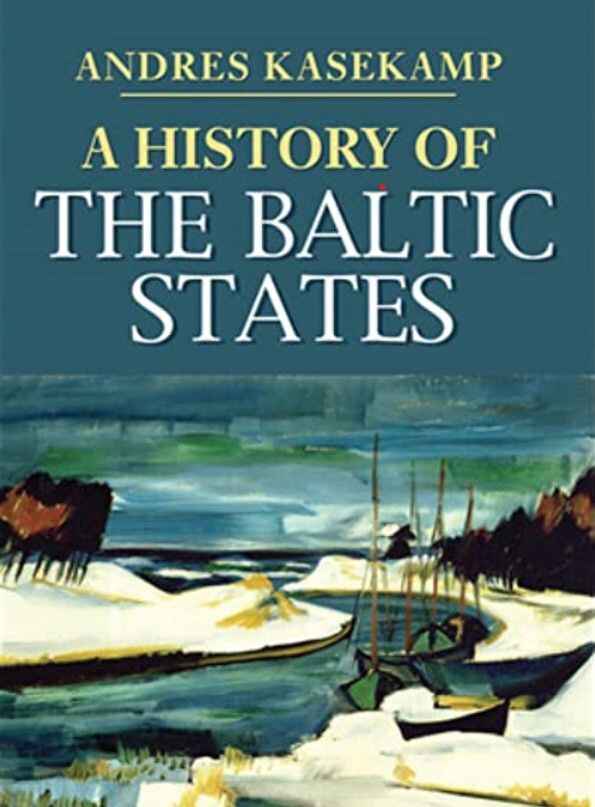
Andres Kasekamp is Professor of Baltic Politics at the University of Tartu, Estonia. His book, A History of the Baltic States, is the best introduction on the subject (Amazon.com, Amazon.de, Amazon.co.uk). On 251 pages, the historian takes the reader from the arrival of the first settlers at the end of the last ice age, around 11,000 BC, to present day Estonia, Latvia and Lithuania.
The Baltic States were never really meant to become known as one “entity”, which they are not. Already linguistically, they are not united. Latvian and Lithuanian are related Baltic languages, branches of the family of Indo-European languages, whereas Estonian is a Finno-Ugric language, which is closely related to Finnish. On the cultural level, Latvians and Estonians are closer related, because of centuries under the rule of German elites, whereas Lithuanians had more in common with the Poles than with the Latvians.
Andres Kasekamp explains that even the meaning of “Baltic” has transformed over time. In the early 20th century, a “Balt” did not refer to an ethnic Estonian, Latvian or Lithuanian, but it was a term of self-identification brought into use in the 19th century by the German ruling elite of the three Russian provinces Estland, Livland and Courland, collectively known as the Ostseeprovinzen of the Russian Empire.
In 1918, the Baltic Germans almost succeeded in uniting the three Russian provinces into a Baltic duchy under the German Kaiser. Only after the First World War did the term “Baltic states” come into use. It remained a fluid term, which included other states that emerged from the collapse of tsarist Russia and often included Finland. The Second World War changed the term again. Finland rebranded herself as a “Nordic” country, whereas the Soviet Republics of Estonia, Latvia and Lithuania became in Russian known as the Pribaltika region. The common destiny under Soviet rule strengthened the Baltic identity. With the collapse of the Soviet Empire, the close cooperation of Estonians, Latvians and Lithuanians led to their independence. In 1992 followed the establishment of the council of Baltic Sea States. In 2004 came the integration into the European Union.
Andres Kasekamp has written a concise, integrated and comparative history of the region. Only two general histories of the Baltic States have been written in English prior to the work by Kasekamp. Most authors had focused on individual country studies.
Andres Kasekamp begins his history of the Baltic States with the retreat of the Scandinavian ice sheet, when the first settlers, nomadic hunters, arrived in the area around 11,000 BC, in the Early Stone Age. A gradual transition to farming was not complete until the Bronze Age. People speaking Finno-Ugric languages moved into the Northern part of the Baltics. Indo-European Balts who settled in the southern part of the Baltic littoral during the Neolithic era. Andres Kasekamp explains that, by the Late Iron Age, these tribes were loosely politically organized, already interacting with Scandinavia and and the Rus’. Crusaders from Germany and Denmark subjugated the proto-Latvian and Estonian tribes, converting Europe’s last pagans to Christianity during the 13th century. The Lithuanian tribes united under a single ruler and successfully resisted the pressure from the Teutonic Knights.
Andres Kasekamp’s history concentrates on the years from 1290 until today. Chapters include on overview over Lithuania’s expansion and Medieval Livonia from 1290 until 1560, the Polish-Lithuanian Commonwealth and the rise of Sweden and Russia between 1561 and 1795, the Tsarist rule from 1795 to 1917 with agrarian reforms and national awakenings, the short era of Independence from 1917 to 1939. The darkest chapters is entitled between Anvil and Hammer from 1939 to 1953, which includes the Soviet annexation, the short period as Nazi Ostland, the fighting in foreign uniforms, the resistance, subsequent repression and collectivization. The Soviet rule from 1953 to 1991 is marked by stagnation and ends with the Singing Revolution and the move towards independence. The return to the West spans from 1991 to 2009, with the joining of the European Union and the NATO alliance, the building of democracies, the introduction of economic reforms and the difficult relations with Russia.
Excellent are the final remarks on further reading. The 11-page annotated bibliography is of great help to readers who would like to dig further into several areas of the Baltic history, including the national histories of Estonia, Latvia and Lithuania. With A History of the Baltic States, in a concise form, Andres Kasekamp offers the best overview available.
Andres Kasekamp: A History of the Baltic States. Palgrave Macmillan, 2010, 251 pages. Order the book from Amazon.com, Amazon.de, Amazon.co.uk.
Books about Estonia from Amazon.com, Amazon.co.uk, Amazon.fr, Amazon.de.

Book review originally added on March 4, 2013. Book review added to our newly designed WordPress pages on March 6, 2023 at 15:03.